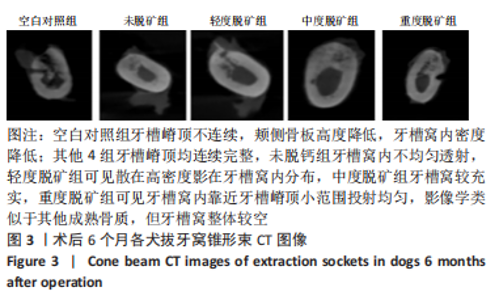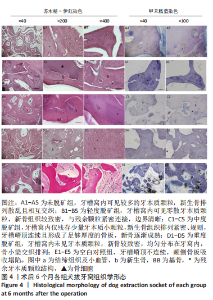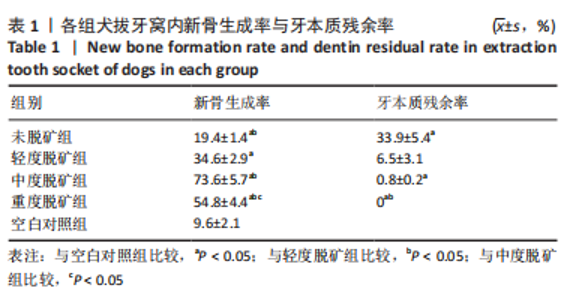[1] WEIJDEN F, DELL’ACQUA F, SLOT DE. Alveolar bone dimensional changes of post-extraction sockets in humans: A systematic review. J Clin Periodontol. 2009; 36(12):1048-1058.
[2] SAKKAS A, WILDE F, HEUFELDER M, et al. Autogenous bone grafts in oral implantology-is it still a “gold standard”? A consecutive review of 279 patients with 456 clinical procedures. Int J Implant Dent. 2017;3:23.
[3] BECKER K, JANDIK K, STAUBER M, et al. Microstructural volumetric analysis of lateral ridge augmentation using differently conditioned tooth roots. Clin Oral Investig. 2019;23:3063-3071.
[4] 崔婷婷,邱泽文,邵阳,等.异种牙本质颗粒复合骨髓浓缩物在上颌窦提升中的成骨效应[J].中国组织工程研究,2018,22(30):4806-4811.
[5] GUAL-VAQUES P, POLIS-YANES C, ESTRUGO-DEVESA A, et al. Autogenous teeth used for bone grafting: A systematic review. Med Oral Patol Oral Cir Bucal. 2018; 23:e112-e119.
[6] JUN SH, AHN JS, LEE JI, et al. A prospective study on the effectiveness of newly developed autogenous tooth bone graft material for sinus bone graft procedure. J Adv Prosthodont. 2014;6:528-538.
[7] MINAMIZATO T, KOGA T, TAKASHI I, et al. Clinical application of autogenous partially demineralized dentin matrix prepared immediately after extraction for alveolar bone regeneration in implant dentistry: a pilot study. Int J Oral Maxillofac Surg. 2018;47:125-132.
[8] SCHWARZ F, GOLUBOVIC V, BECKER K, et al. Extracted tooth roots used for lateral alveolar ridge augmentation: a proof-of-concept study. J Clin Periodontol. 2016;43:345-353.
[9] SCHWARZ F, GOLUBOVIC V, MIHATOVIC I, et al. Periodontally diseased tooth roots used for lateral alveolar ridge augmentation. A proof-of-concept study. J Clin Periodontol. 2016;43:797-803.
[10] SCHWARZ F, HAZAR D, BECKER K, et al. Effificacy of autogenous tooth roots for lateral alveolar ridge augmentation and staged implant placement. A prospective controlled clinical study. J Clin Periodontol. 2018;45:996-1004.
[11] SCHWARZ F, SAHIN D, BECKER K, et al. Autogenous tooth roots for lateral extraction socket augmentation and staged implant placement. A prospective observational study. Clin Oral Implants Res. 2019;30:439-446.
[12] KIM YK, KIM SG, BYEON JH, et al. Development of a novel bone grafting material using autogenous teeth. Oral Surg Oral Med Oral Pathol Oral Radiol Endodontol. 2010;109:496-503.
[13] KABIR MA, MURATA M, SHAKYA M, et al. Bio-Absorption of Human Dentin-Derived Biomaterial in Sheep Critical-Size Iliac Defects. Materials. 2021;14(1):223.
[14] XIAO W, HU C, CHU C, et al. Autogenous Dentin Shell Grafts Versus Bone Shell Grafts for Alveolar Ridge Reconstruction: A Novel Technique with Preliminary Results of a Prospective Clinical Study. Int J Periodontics Restorative Dent. 2019; 39(6):885-893.
[15] 赵彬彬,仲维剑,马国武,等.三种不同骨移植材料成骨效果的比较[J].中国组织工程研究,2021,25(10):1507-1511.
[16] MURATA M. Chemical Properties of Human Dentin Blocks and Vertical Augmentation by Ultrasonically Demineralized Dentin Matrix Blocks on Scratched Skull without Periosteum of Adult-Aged Rats. Materials. 2021;15(1):105.
[17] LI S, GAO M, ZHOU M, et al. Bone augmentation with autologous tooth shell in the esthetic zone for dental implant restoration: a pilot study. Int J Implant Dent. 2021;7(1):108.
[18] COUSO-QUEIRUGA E, STUHR S, TATTAN M, et al. Post‐extraction dimensional changes: A systematic review and meta‐analysis. J Clin Periodontol. 2020;48:127-145.
[19] LAI SY, HOU JX. Progress in the application of alveolar ridge preservation at extraction sites in non-periodontitis and periodontitis patients. Zhonghua Kou Qiang Yi Xue Za Zhi. 2020; 55(4):266-270.
[20] FELLER L, KHAMMISSA RA, BOUCKAERT M, et al. Alveolar ridge preservation immediately after tooth extraction. J S Afr Dent Assoc. 2013;68(9):408.
[21] KIM ES, KANG JY, KIM JJ, et al. Space maintenance in autogenous fresh demineralized tooth blocks with platelet-rich plasma for maxillary sinus bone formation: a prospective study. Springerplus. 2016;5:274.
[22] SÁNCHEZ-LABRADOR L, MARTÍN-ARES M, ORTEGA-ARANEGUI R, et al. Autogenous Dentin Graft in Bone Defects after Lower Third Molar Extraction: A Split-Mouth Clinical Trial. Materials (Basel). 2020;13(14):3090.
[23] BATH-BALOGH M, FEHRENBACH MJ. Illustrated dental embryology, histology, and anatomy. 2nd ed. Philadelphia: Elsevier, 2006.
[24] KADKHODAZADEH M, GHASEMIANPOUR M, SOLTANIAN N, et al. Effects of fresh mineralized dentin and cementum on socket healing: a preliminary study in dogs. J Korean Assoc Oral Maxillofac Surg. 2015;41:119-123.
[25] MURATA M, AKAZAWA T, TAKAHATA M, et al. Bone induction of human tooth and bone crushed by newly developed automatic mill. J Ceram Soc Jpn. 2010;118:434-437.
[26] KIM YK, KIM SG, YUN PY, et al. Autogenous teeth used for bone grafting: a comparison with traditional grafting materials. Oral Surg Oral Med Oral Pathol Oral Radiol. 2014;117(1):e39-e45.
[27] 刘欢,王宁,仲维剑,等.部分脱矿自体牙本质颗粒联合PRF在拔牙位点保存中的应用1例[J].口腔医学研究,2022,38(1):90-91.
[28] 赵彬彬,仲维剑,马国武.牙本质作为骨移植材料的研究进展[J].国际口腔医学杂志,2021,48(1):82-89.
[29] LI R, GUO W, BO Y, et al. Human treated dentin matrix as a natural scaffold for complete human dentin tissue regeneration. Biomaterials. 2011;32(20):4525-4538.
[30] LEE JY, KIM YK, YI YJ, et al. Clinical evaluation of ridge augmentation using autogenous tooth bone graft material. J Korean Assoc Oral Maxillofac Surg. 2013; 39:156-160.
[31] KOGA T, MINAMIZATO T, KAWAI Y, et al. Bone Regeneration Using Dentin Matrix Depends on the Degree of Demineralization and Particle Size. Plos One. 2016; 11(1):e0147235.
|





